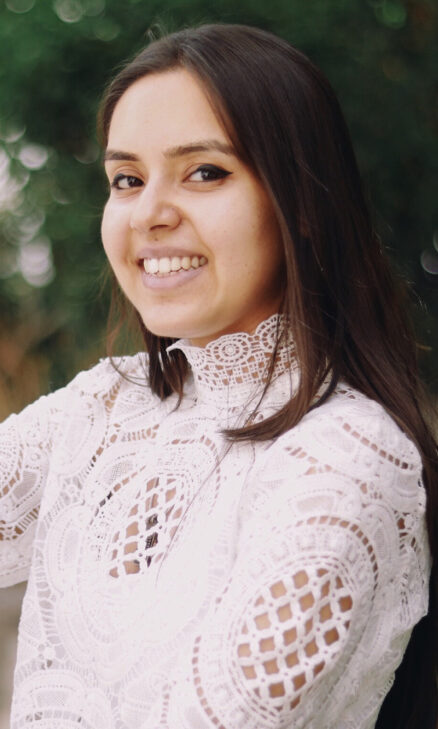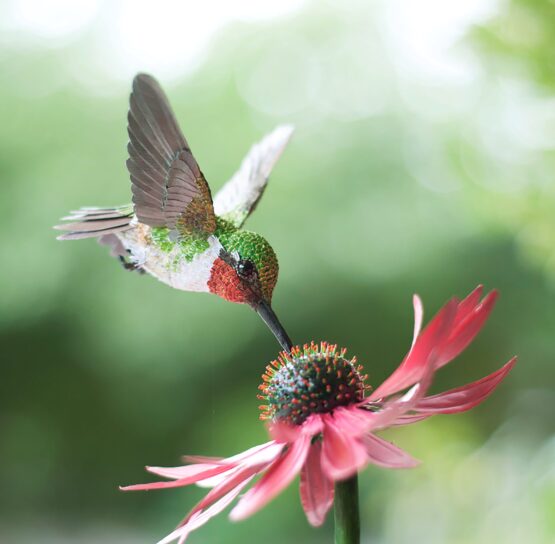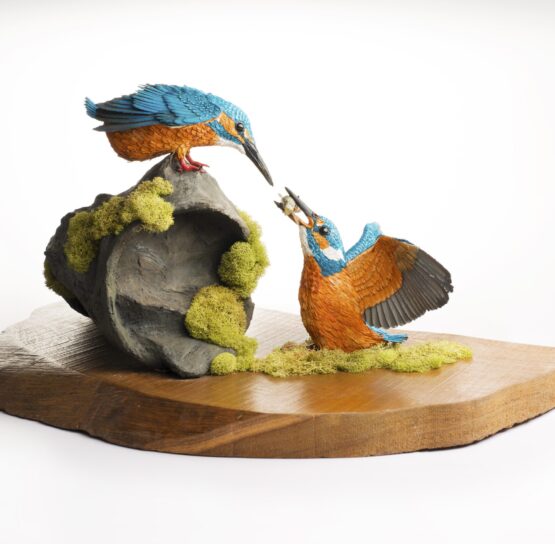Niharika Rajput
by Manica Pathak
New Delhi–based artist and National Geographic explorer Niharika Rajput transforms paper into lifelike three-dimensional sculptures of birds and animals, blending meticulous craftsmanship with a mission to raise awareness about endangered species.
New Delhi–based artist and National Geographic explorer Niharika Rajput transforms paper into detailed three-dimensional sculptures, layering and shaping each piece to capture the lifelike presence of birds and animals. A graduate in English Literature from Delhi University, Niharika began her career as an assistant designer at People Tree before transitioning to wildlife art in 2013. Demanding a labour-intensive process, her practice is grounded in research and a precise study of wildlife anatomy–qualities that lend her works their plausible realism. While the attention to detail makes Niharika's artworks visually sublime, it is the powerful message and mission behind them that lend them their true significance. Each custom-made piece serves as a ‘call to attention’, highlighting endangered species and the urgent need to protect and restore wildlife. Such advocacy rising from artists today has drawn support from diverse quarters within the country as well as across borders. For Niharika, it has led to numerous solo and group exhibitions since 2014, beginning with GALLERYSKE in New Delhi, even before founding her own studio, Paper Chirrups, in 2015. Her works have also been featured at the Ladakh Bird Festival with LAMO (Ladakh Arts and Media Organisation), Platform Galeri in Betws-y-Coed, Wales, and at institutions such as the Allan Brooks Nature Centre and the Caetani Cultural Centre in British Columbia. At the heart of this growing acclaim is the process that underpins Niharika’s signature style. For each project, Niharika designs a customised wire framework, layering them with several hand-fringed feathers and sculpting them to capture the movement of birds in flight, the subtle shifts of colour in their plumage, and the textures that define them. It points towards a cultural moment in the country where contemporary artists are becoming increasingly multifaceted, utilising both skill and passion not only as means of creative expression but also as tools for awareness and change. Although art has long held the potential to drive activism, education, and community engagement, today that role is gaining fresh momentum, evident in the calibre of educational and creative sessions that Niharika’s works have attracted. Over the years, she has conducted workshops with wildlife organisations, art galleries, nature interpretation centres, and forest departments, while her client list has grown to include names like Adobe Systems and Les Petits. What’s particularly noteworthy is how artists today are unafraid to embrace their passions, experiment with niche mediums, and build thriving practices around them. In tandem, the voice of each artist, whether in a specialised or mainstream practice, is achieving relevance and global recognition. Her journey also reflects one of the many ongoing shifts in India’s homegrown art scene, where artists are increasingly prioritising the multipotential of art beyond mere ‘objects of beauty.’



Niharika speaks to Blur The Border :
Blur : With an academic background in language and literature and professional experience in design to now paper sculpting to create awareness about wildlife conservation, how did you navigate these career pivots? Was there a mentor who played a role in shaping your journey?
Niharika : I was always a nature loving child, I often found myself outdoors observing insects , collecting fireflies and looking at birds making their nests and preening their feathers. It always felt right being outdoors. Nature has always been and continues to be my refuge. Growing up I picked art as my hobby and loved building 3 dimensional objects. I didn’t know at the time that my love for nature and art would amplify into a full fledged career path. I have had many mentors who have shaped my journey and continue to inspire me to expand my work. This amalgamation of art and wildlife conservation happened very organically and still continues to grow and expand. I started my career at People Tree , Delhi where I experimented with a lot of different materials and built very simple miniature bird models. I was interning at the organisation while I was still in college and I am completely self taught , I did not attend any art school. I stumbled upon a documentary by Tim Laman and Ed Scholes ( National Geographic Explorers) on the Birds of Paradise, along with sightings of Red Billed Blue Magpies in Himachal inspired me to change my course completely. I picked up a small grant from ATREE and led a series of workshops on birds in Ladakh and that was the beginning of my career as a Wildlife Artist. If I were to name just one mentor who played a pivotal role in my journey so far , it has to be Dr V.V. Robin, evolutionary biologist and professor at IISER , Tirupati who has been studying Shola birds found in the Western Ghats for the last 24 years. He helped me tap into my potential as a Wildlife artist and informal educator and showed me how I can use my work to educate and inspire the next generation of eco-warriors.
Blur : Your work sits at a unique intersection of art and wildlife conservation. What drew you to paper sculpture as a medium for raising awareness about wildlife restoration and protection? Are there any other mediums you are looking to explore in the future?
Niharika : My art practice began with me building abstract sculptures which were inspired by nature and wildlife and I experimented with an array of materials namely, cane, wire, textiles, clay etc. I landed on paper because paper is the only material that beautifully and accurately replicates the texture of real bird feathers. Working with paper has shown me the versatility this medium brings to the table. I have created sculptures of reptiles and mammals using paper on the inside and outside. Paper can be used to create scales and fur beautifully , I have also used paper and paper mache clay to construct habitats for these birds. Constructing grasslands , rock formations, plants etc out of paper. I am amazed by how paper can be used in many different ways to create objects which I wouldn’t have imagined creating in the past. My sculptures are realistic replicas and are often mistaken for taxidermy models. The nature of my work allows me to create natural history museum set ups which can be used to educate the local community. These immersive experiences include an exhibit of the sculptures , an animation movie and use of cutting edge technology like motion sensors and movement mechatronics to enhance the overall experience. All of this lined with hands-on workshops and outdoor sessions act as a springboard into deeper exploration.
Blur : Do you have a definitive process while creating? Are there any habits or rituals that help you get into a creative mindset?
Niharika : Yes , I do follow a process. It usually begins with a lot of research, collecting morphometric measurements for the birds, putting together a repository of photographs and videos which will help stitch together a 3 dimensional view of the birds. I begin by sketching out all the body parts in detail and create stencils for all the wing and tail feathers. Then I start building the armature which is made using wire and paper. Once the armature is ready I work on the facial features and legs using clay. Thin strips of paper are used to cover the entire armature because it gives an even surface to work on. This is followed by cutting off a lot of paper feathers , each feather is strategically glued onto the bird's body . Once the feathers are in place then the bird is painted using acrylic paints. Going for a run in nature is my morning ritual without which I can’t function. I have to spend at least an hour in nature before getting down to work. This is followed by a small meditation practice and chanting. This helps me get into my creative mindset.
Blur : What role does the environment play in your work or in fueling your creativity?
Niharika : Nature plays a huge role in my work. Nature has the most sophisticated mechanisms in place whether it is symbiosis , mycelial networks playing a crucial role in how trees communicate and share nutrients , birds being the greatest architects , it’s a never ending list of magical occurrences. There is so much inspiration in nature and a huge part of spending time outside is to go on multidimensional walks and observe closely. These observations help fuel my creativity.
Blur : How has your artistic style evolved over the years, and how do you view this evolution?
Niharika : My artistic style has evolved greatly over the years but it still continues to be a learning process . I started building birds with clay and textile first and shifted to paper after realising that it was the only material that could replicate the texture of the feathers perfectly. At first it was all about getting the proportions right , the facial features right and having the bird perch on a rock or a wooden stump. Once I was satisfied with that, I wanted the birds to be more animated, shown in action , drinking nectar , exchanging fish during a mating ritual etc. Now I have a set process in place and have evolved some of the steps which help cut down the time drastically. My work has also evolved from just building individual pieces to creating dioramas where I also get to work on the landscapes in which these birds and animals are found.
Blur : How do you see art playing a role in shaping public understanding and empathy for wildlife?
Niharika : Art plays a huge role in shaping public understanding and empathy for our wildlife because it takes an alternative and interesting approach to reach people and communicate the same issues at hand. Wildlife conservation often involves intricate science—genetics, habitats, Morphology etc. Art translates this complexity into stories and symbols, visual science communication is known to simplify science. Art is a very effective tool to do that. This clarity is amplified when visuals are combined with hands-on experiences through workshops and outdoor sessions.
Blur : The impact of art and creating awareness can often be intangible. How do you measure the impact of your work, not just visually, but in terms of awareness or behavioral change?
Niharika : We often give out formative and summative feedback forms to measure and evaluate the impact of our work. I always try to pass on my skills to members of the local community , which I have successfully done in the past and have seen my workshop models being implemented even in my absence.
Blur : At a time when much of the world is turning to digital tools and AI-generated art, how do you see handcrafted work holding its ground and evolving in this new landscape?
Niharika : We can use AI to our advantage in many ways. I work very closely with an electronics engineer and graphic designer who are switching to new tools to work more efficiently. My work supported with cutting edge technology can enhance the overall experience for visitors.
Handcrafted work continues to hold unique value , In a world where digital replication is fast and easy, handcrafted work represents authenticity. Every imperfection is a mark of the maker, something AI-generated work can’t truly emulate.
Many handcrafted traditions are deeply tied to heritage, identity, and storytelling. These are not just techniques, they're lineages, and people are increasingly valuing that depth. Consumers are becoming more conscious. Handmade goods are often perceived as more sustainable, ethical, and enduring compared to mass-produced items. A handcrafted item often comes with a story. Buyers feel a stronger emotional connection to a maker or their process, which AI lacks.
Blur : If you were to collaborate with an artist or organisation outside of your discipline, who would it be?
Niharika : I would love to explore stop motion animation and collaborate with Disney at some point and I would absolutely love to collaborate with artists like Chris Ritson who are creating art using mycelium and many others who are working with algae and corals to grow their art.